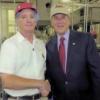What is considered 'enclosed product areas'?
1) If left over ingredient is used in production, and it is then folded up, covered, within production area, before it is returned to the warehouse, can the warehouse be considered enclosed product areas?
2) What about staging areas? The shrink wrap is removed, potentially taping can be removed, but the ingredients are not yet taken out of packaging.
If it is only considered as "enclosed" when product is completely sealed in a case (ie. if product are individually wrapped, and then placed in a case), are we still able to divide the warehouse into areas that is "low risk" vs "enclosed product areas"?

















